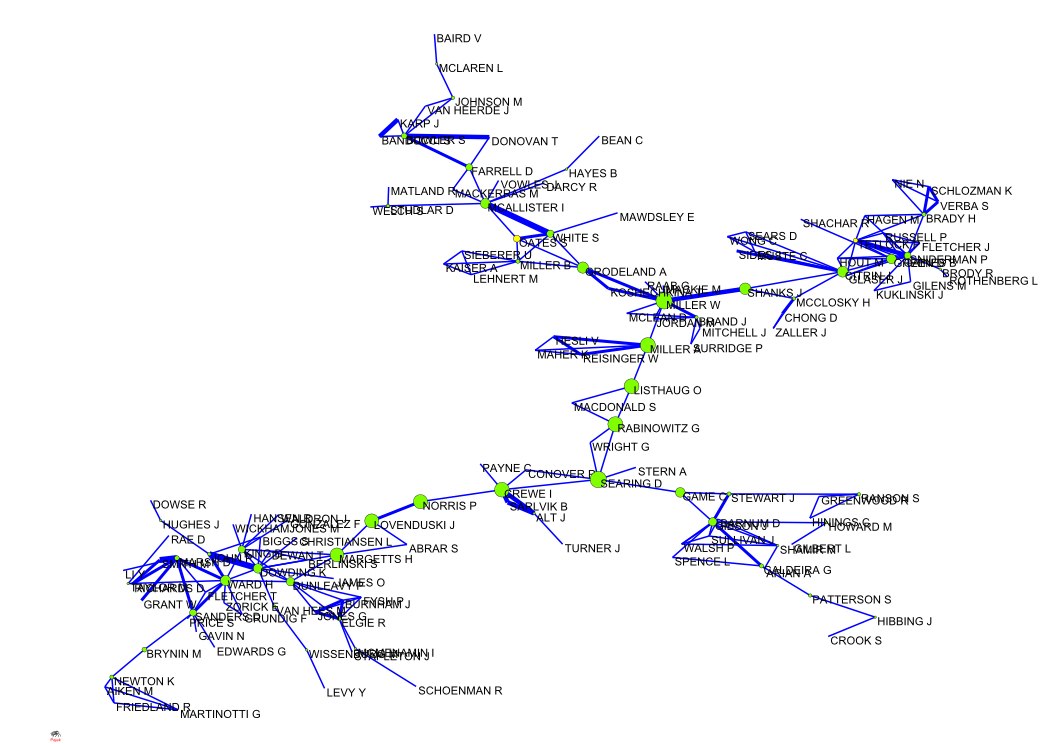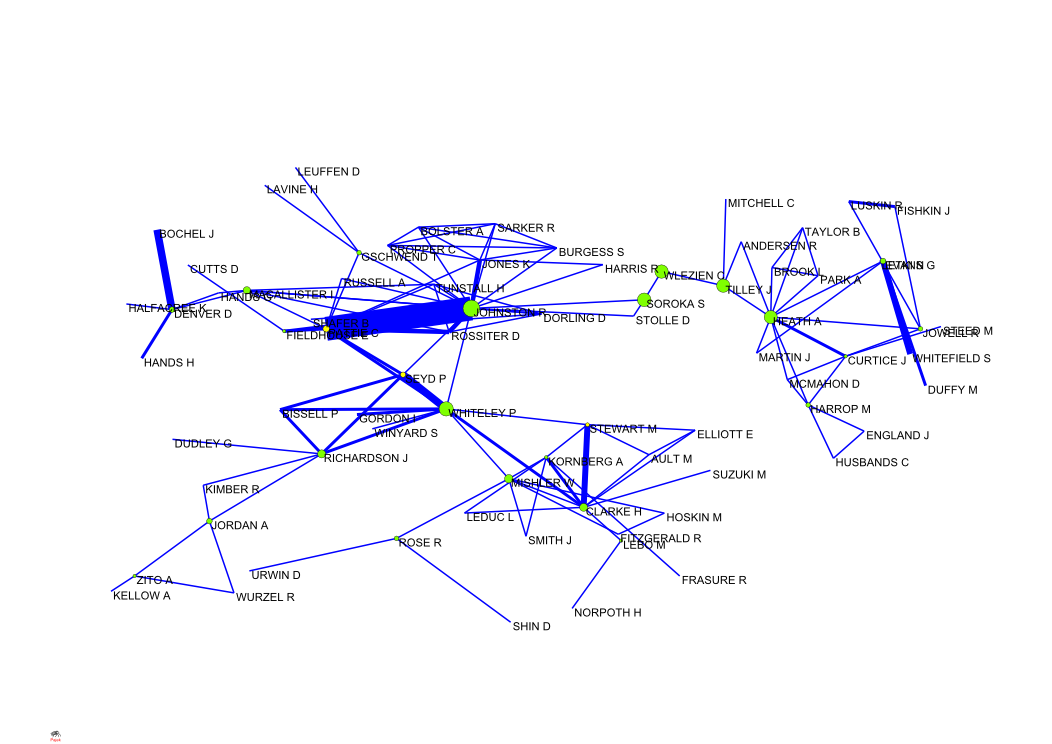Co-publications in British Political Science (BJPS and PS)
Patterns of Collaboration in British Political Science: Political Studies
Political Studies features 161 co-publication networks. Seven of them exceed the threshold of six members, and the three largest of them have 16, 19, and 21 members respectively. These networks are not only larger than PVS subnetworks but are also denser, feature overlapping triads, and display patterns of sustained co-operation between small subgroups of authors. The intensity of the co-operation between Johnston, Pattie, Seyd and Whiteley is particularly striking: Johnston and Pattie alone have jointly published five articles in Political Studies. Although the percentage of co-authored articles is roughly the same for both journals, and although the concentration of authorship in both journals seems to be rather low - more than 80 per cent of all authors do not publish more than one article in the respective journal - co-publishing seems to play a more prominent role in PS. Even if one accounts for the larger number of articles that have been published in PS, we conclude from this that scientific co-operation in the form of co-publication is much more prominent in PS than in PVS.
Patterns of Collaboration in British Political Science: British Journal of Political Science
In the BJPS, we find more, larger and denser networks than in both Political Studies and Politische Vierteljahresschrift. In this journal, the 607 collaborating authors form 165 co-publication networks, 17 of which have six or more members. Amongst these, seven are particularly large in comparison with the findings for PS and PVS, i.e. they have between 15 and 48 members. Given the size of these networks, it is worthwhile to employ standard techniques for finding particularly dense pockets. Applying k-cores (after replacing multiple with single ties), we find that one of the medium-sized networks with 16 members stands out because 11 of its members form the only 5-core in our data. The importance of this region is slightly exaggerated by two articles which each have a unusually high number of co-authors (6), but even so, this is clearly a highly productive network of scholars. At its centre, we find again Johnston and Pattie, who have jointly authored 11 (!) articles in BJPS. Three other networks feature 4-cores. Again, single articles with unusually high numbers of contributors play a role here, but in every case, a subgroup of authors of two or three authors within the core has repeatedly published together. The sheer size, number and density of these networks all suggest that co-publication is a much more important channel for scientific collaboration in the two other journals.
Patterns of Collaboration in Elite British Political Science Journals
Given the status of BJPS and PS as the UK's most important general political science journals, it makes sense to merge our data on co-publications in both journals to get a glimpse of more general patterns of co-publication within the British political science community. This yields a new data set of 964 co-publishing authors who are involved in 257 co-publication networks, most of which are tiny. However, roughly one third of them (272) are involved in four large components with at least 15 members. Two of these are of comparatively moderate size (21 and 29 members), whereas the other two have 77 and 145 members respectively.
However, the collaboration network in the UK looks rather sparse in absolute terms. Only 15 per cent of all co-publishing authors are members of the largest component, whereas Newman (2001), who analyses data on collaboration in physics, computer science, bio-medical research and other sciences, reports the existence of a 'giant component' that includes between 57 and 93 per cent of the authors. Moreover, the size of the second largest component in Newman's data is typically less than 0.5 per cent the size of the giant component, and within the giant component, the average degree of separation is relatively low, i.e. about six. While we have to keep in mind that we are only looking at two prominent British journals whereas Newman analyses much larger disciplinary networks that span the whole globe, it seems striking how fragile the network actually is. Even the largest component clearly consists of four dense regions that are only connected by a long, stringy structure.

This is readily apparent from the figure, where cut vertices are green and vertex size is proportional to betweenness centrality. Removing a single author in the chain that links Margaretts in the lower left corner to Warren Miller just right above the centre would split the component in two or three. Compared with Newman's findings, the average distance between authors is high (9.3) (no six degrees of separation here!), while the average number of collaborators is low (3).

In our view, the fact that the two most prolific collaborators in British political science - Johnston and Pattie who have jointly published 16 articles in BJPS and PS - are not part of the largest component is also telling. They are at the centre of one of dense region in the second largest component, but again, links between these regions are provided by a small number of scholars including Johnston. Without them, the component would break apart.